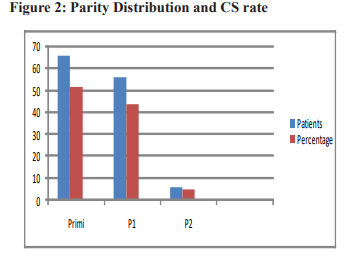Abstract
Background : Caesarean section (CS) is one of the
commonest obstetrics procedure to reduce the risks for
mother and fetus when vaginal delivery is not anticipated
. The objective of the study was to determine the rate and
clinical indication of Caesarean section.
Materials and Methods: This was a hospital based
descriptive retrospective study done within a time frame of
a year (from Shrawan 2075 BS to Ashad 2076 BS; 17 July
2018 to July 16 2019) in Matri Shishu Miteri Hospital,
Pokhara,Nepal. The total number of deliveries, their modes
of delivery, indication for the Cesarean section, age group,
number of parity, period of gestation and type of Caesarean
section either elective or emergency were descriptively
analyzed.
Results: A total of five hundred and eighty eight cases
underwent delivery during the study period. Of them
128 (21.76%) cases were delivered by Caesarean
section. Analysis revealed that the common age group
for the CS patients was between 20-30 years (64.8%) of
them 66 (51.6%) cases were primi gravida. Emergency
Caesarean section was done for 75(58.6%) cases and
elective Caesarean section for 53(41.4%) cases. The
most common indication for Caesarean section was
found to be previous caesarean section 21% (n=27),
cephalopelvic disproportion (CPD) 18% (n=23), fetal
distress 18% (n=23), failed induction 14.1% (n=18),
breech presentation 10.2 %( n=13), non progress of
labor (NPOL) 9.4 %( n=12) and oligohydramnios
7.8% (n=10).
Conclusion: Our study revealed that the rate of
Caesarean section is higher than that recommended
by World Health Organization (WHO), which
needed to be 10-15% of the total deliveries. The
common indications for Caesarean sections were
pervious Caesarean section, fetal distress, CPD, failed
induction, breech presentation, non progress of labour
(NPOL) and oligohydramnios among others.
References
statement on caesarean section rates.
Geneva:World Health Organization, 2015.
2. Cai WW, Marks JS, Chen CH,Zhuan YX,
Morris L,Harris JR. Increased cesarean
section and emerging pattern of health
insurance in Shanghai, China. Am J Public
Health.1998;88(5);777-80.
3. Saha S, Das R, Chakraborty M, Bala HS,
Naskar P. A Paradigm Shift to check the
increasing trend of caesarean delivery is the
need to tohour:but how? Obstet Gynecol
india, 2012;62(4):391-7.
4. Mukherjee SN. Rising Caesarean RateObstetGynecol India.2006;56(4):298-300.
5. Chaudhary, Rajendra etal, Prevalance
and Indication of Cesarean Section in a
Community Hospital of Western Region of
Nepal. JNMA,2018;56(213)871-4.
6. Prasad, Apurwaetal, Profile of Caesarean
Section at Kathmandu Medical College.
J Nepal Health Res Counc.2017MayAug;15(36):110-13.
7. Sharma A, Sharma U, Chaudhary
P,Acharya A,Chaudhary A,Hanspal
J. Maternal and Neonatal outcomes
in Patients with history of previous
one caesarean section. Indian Medical
Gazette.2012;145 (5):169-73.
8. Sulochana Dhakal Rai, Pramod Raj Regmi,
Edwin van Teijlingen,Juliet Wood, Ganesh
Dangal, Keshar Bahadur Dhakal. Rising
Rates of Caesarean Section in Urban
Nepal. J Nepal Health Res. Counc 2018.
oct-dec;16(4):479-80.
9. Ministry of Health and Population and
New ERA,ICF International, Nepal
Demographic and Health Survey
2016.Kathmandu Ministry of Health
and Population,New ERA and ICF
International,Calverton,Maryland,2017
10. Hannah M, Hannah.W.Caesarean section
or vaginal birth for breech presentation at
term.BMJ.1996Jun,312:1433-4.PMCJ.

